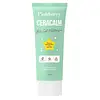What's inside
What's inside
 Key Ingredients
Key Ingredients

 Benefits
Benefits

 Concerns
Concerns

 Ingredients Side-by-side
Ingredients Side-by-side

Water
Skin ConditioningPanthenol
Skin ConditioningButylene Glycol
HumectantPropanediol
SolventGlycerin
HumectantPhenoxyethanol
PreservativeAmmonium Acryloyldimethyltaurate/Vp Copolymer
PEG-40
HumectantTetrasodium EDTA
Allantoin
Skin ConditioningCarbomer
Emulsion StabilisingEthylhexylglycerin
Skin ConditioningAminomethyl Propanol
BufferingVitis Vinifera Leaf Extract
Skin ConditioningPorphyridium Polysaccharide
AntioxidantCaprylic/Capric Triglyceride
MaskingDeoxyphytantriyl Palmitamide Mea
Skin ConditioningHydrogenated Lecithin
EmulsifyingCeramide NP
Skin ConditioningCholesterol
EmollientHamamelis Virginiana Extract
AntiseborrhoeicHydrolyzed Collagen
EmollientWater, Panthenol, Butylene Glycol, Propanediol, Glycerin, Phenoxyethanol, Ammonium Acryloyldimethyltaurate/Vp Copolymer, PEG-40, Tetrasodium EDTA, Allantoin, Carbomer, Ethylhexylglycerin, Aminomethyl Propanol, Vitis Vinifera Leaf Extract, Porphyridium Polysaccharide, Caprylic/Capric Triglyceride, Deoxyphytantriyl Palmitamide Mea, Hydrogenated Lecithin, Ceramide NP, Cholesterol, Hamamelis Virginiana Extract, Hydrolyzed Collagen
Water
Skin ConditioningCyclopentasiloxane
EmollientPanthenol
Skin ConditioningButylene Glycol
HumectantSodium PCA
HumectantCaprylic/Capric Triglyceride
MaskingGlycerin
HumectantCarbomer
Emulsion StabilisingPolysorbate 20
EmulsifyingAllantoin
Skin ConditioningUrea
BufferingTriethanolamine
BufferingHydroxyethyl Acrylate/Sodium Acryloyldimethyl Taurate Copolymer
Emulsion StabilisingDMDM Hydantoin
PreservativeIsohexadecane
EmollientPolyacrylate-13
Styrene
PerfumingBHT
AntioxidantDisodium EDTA
PPG-26-Buteth-26
Skin ConditioningPolyisobutene
Phenoxyethanol
PreservativeBisabolol
MaskingTocopheryl Acetate
AntioxidantZiziphus Jujuba Fruit Extract
Skin ConditioningPEG-40 Hydrogenated Castor Oil
EmulsifyingPaeonia Lactiflora Root Extract
Skin ConditioningScutellaria Baicalensis Root Extract
AstringentEthylhexyl Methoxycinnamate
UV AbsorberPolysorbate 60
EmulsifyingSorbitan Isostearate
EmulsifyingGlycyrrhiza Glabra Root Extract
BleachingSodium Benzoate
MaskingButyl Methoxydibenzoylmethane
UV AbsorberEthylhexyl Salicylate
UV AbsorberOpuntia Ficus-Indica Stem Extract
Skin ConditioningCitric Acid
BufferingWater, Cyclopentasiloxane, Panthenol, Butylene Glycol, Sodium PCA, Caprylic/Capric Triglyceride, Glycerin, Carbomer, Polysorbate 20, Allantoin, Urea, Triethanolamine, Hydroxyethyl Acrylate/Sodium Acryloyldimethyl Taurate Copolymer, DMDM Hydantoin, Isohexadecane, Polyacrylate-13, Styrene, BHT, Disodium EDTA, PPG-26-Buteth-26, Polyisobutene, Phenoxyethanol, Bisabolol, Tocopheryl Acetate, Ziziphus Jujuba Fruit Extract, PEG-40 Hydrogenated Castor Oil, Paeonia Lactiflora Root Extract, Scutellaria Baicalensis Root Extract, Ethylhexyl Methoxycinnamate, Polysorbate 60, Sorbitan Isostearate, Glycyrrhiza Glabra Root Extract, Sodium Benzoate, Butyl Methoxydibenzoylmethane, Ethylhexyl Salicylate, Opuntia Ficus-Indica Stem Extract, Citric Acid
Ingredients Explained
These ingredients are found in both products.
Ingredients higher up in an ingredient list are typically present in a larger amount.
Allantoin is a soothing ingredient known for its protective and moisturizingg properties. Because of this, it is often added to products with strong active ingredients.
Studies show higher concentrations of this ingredient can promote wound healing.
Though it can be derived from the comfrey plant, allantoin is produced synthetically for cosmetic products to ensure purity.
Learn more about AllantoinButylene Glycol (or BG) is used within cosmetic products for a few different reasons:
Overall, Butylene Glycol is a safe and well-rounded ingredient that works well with other ingredients.
Though this ingredient works well with most skin types, some people with sensitive skin may experience a reaction such as allergic rashes, closed comedones, or itchiness.
Learn more about Butylene GlycolThis ingredient is an emollient, solvent, and texture enhancer. It is considered a skin-softener by helping the skin prevent moisture loss.
It helps thicken a product's formula and makes it easier to spread by dissolving clumping compounds.
Caprylic Triglyceride is made by combining glycerin with coconut oil, forming a clear liquid.
While there is an assumption Caprylic Triglyceride can clog pores due to it being derived from coconut oil, there is no research supporting this.
Learn more about Caprylic/Capric TriglycerideCarbomer is a polymer of acrylic acid. Its main role is to create a gel consistency.
A high amount of carbomer can cause pilling or balling up of products. Don't worry, most products contain 1% or less of carbomer.
Glycerin is already naturally found in your skin. It helps moisturize and protect your skin.
A study from 2016 found glycerin to be more effective as a humectant than AHAs and hyaluronic acid.
As a humectant, it helps the skin stay hydrated by pulling moisture to your skin. The low molecular weight of glycerin allows it to pull moisture into the deeper layers of your skin.
Hydrated skin improves your skin barrier; Your skin barrier helps protect against irritants and bacteria.
Glycerin has also been found to have antimicrobial and antiviral properties. Due to these properties, glycerin is often used in wound and burn treatments.
In cosmetics, glycerin is usually derived from plants such as soybean or palm. However, it can also be sourced from animals, such as tallow or animal fat.
This ingredient is organic, colorless, odorless, and non-toxic.
Glycerin is the name for this ingredient in American English. British English uses Glycerol/Glycerine.
Learn more about GlycerinPanthenol is a common ingredient that helps hydrate and soothe the skin. It is found naturally in our skin and hair.
There are two forms of panthenol: D and L.
D-panthenol is also known as dexpanthenol. Most cosmetics use dexpanthenol or a mixture of D and L-panthenol.
Panthenol is famous due to its ability to go deeper into the skin's layers. Using this ingredient has numerous pros (and no cons):
Like hyaluronic acid, panthenol is a humectant. Humectants are able to bind and hold large amounts of water to keep skin hydrated.
This ingredient works well for wound healing. It works by increasing tissue in the wound and helps close open wounds.
Once oxidized, panthenol converts to pantothenic acid. Panthothenic acid is found in all living cells.
This ingredient is also referred to as pro-vitamin B5.
Learn more about PanthenolPhenoxyethanol is a preservative that has germicide, antimicrobial, and aromatic properties. Studies show that phenoxyethanol can prevent microbial growth. By itself, it has a scent that is similar to that of a rose.
It's often used in formulations along with Caprylyl Glycol to preserve the shelf life of products.
Water. It's the most common cosmetic ingredient of all. You'll usually see it at the top of ingredient lists, meaning that it makes up the largest part of the product.
So why is it so popular? Water most often acts as a solvent - this means that it helps dissolve other ingredients into the formulation.
You'll also recognize water as that liquid we all need to stay alive. If you see this, drink a glass of water. Stay hydrated!
Learn more about Water